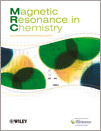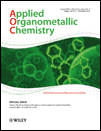
Organometallic chemistry is the study of organometallic compounds, chemical compounds containing at least one chemical bond between a carbon atom of an organic molecule and a metal, including alkali, alkaline earth, and transition metals, and sometimes broadened to include metalloids like boron, silicon, and selenium, as well. Aside from bonds to organyl fragments or molecules, bonds to 'inorganic' carbon, like carbon monoxide, cyanide, or carbide, are generally considered to be organometallic as well. Some related compounds such as transition metal hydrides and metal phosphine complexes are often included in discussions of organometallic compounds, though strictly speaking, they are not necessarily organometallic. The related but distinct term "metalorganic compound" refers to metal-containing compounds lacking direct metal-carbon bonds but which contain organic ligands. Metal β-diketonates, alkoxides, dialkylamides, and metal phosphine complexes are representative members of this class. The field of organometallic chemistry combines aspects of traditional inorganic and organic chemistry.

Tetrahydrofuran (THF), or oxolane, is an organic compound with the formula (CH2)4O. The compound is classified as heterocyclic compound, specifically a cyclic ether. It is a colorless, water-miscible organic liquid with low viscosity. It is mainly used as a precursor to polymers. Being polar and having a wide liquid range, THF is a versatile solvent.

Organotin chemistry is the scientific study of the synthesis and properties of organotin compounds or stannanes, which are organometallic compounds containing tin–carbon bonds. The first organotin compound was diethyltin diiodide, discovered by Edward Frankland in 1849. The area grew rapidly in the 1900s, especially after the discovery of the Grignard reagents, which are useful for producing Sn–C bonds. The area remains rich with many applications in industry and continuing activity in the research laboratory.

Dalton Transactions is a weekly peer-reviewed scientific journal covering original (primary) research and review articles on all aspects of the chemistry of inorganic, bioinorganic, and organometallic compounds. It is published by the Royal Society of Chemistry and the editor-in-chief is Russell Morris. The journal was named after the English chemist, John Dalton, best known for his work on modern atomic theory. The journal was named a "rising star" in 2006.

Advanced Functional Materials is a peer-reviewed scientific journal, published by Wiley-VCH. Established in February 2001, the journal began to publish monthly in 2002 and moved to 18/year in 2006, biweekly in 2008, and weekly in 2013.
The Science Citation Index Expanded – previously titled Science Citation Index – is a citation index originally produced by the Institute for Scientific Information (ISI) and created by Eugene Garfield.

Magnetic Resonance in Chemistry is a monthly peer-reviewed scientific journal covering the application of NMR, ESR, and NQR spectrometry in all branches of chemistry. The journal was established in 1969 and is published by John Wiley & Sons. The editors-in-chief are Roberto R. Gil and Gary E. Martin.
The Journal of Labelled Compounds and Radiopharmaceuticals is a peer-reviewed scientific journal that was established in 1965. It is published in fourteen issues per year by John Wiley & Sons on behalf of the International Isotope Society and covers all aspects of research and development leading to and resulting in labelled compound preparation. The current editor-in-chiefs are R F Dannals and V Derdau.
X-Ray Spectrometry is a bimonthly peer-reviewed scientific journal established in 1972 and published by John Wiley & Sons. It covers the theory and application of X-ray spectrometry. The current editor-in-chiefs are Johan Boman and Liqiang Luo.

The Journal of Raman Spectroscopy is a monthly peer-reviewed scientific journal covering all aspects of Raman spectroscopy, including Higher Order Processes, and Brillouin and Rayleigh scattering. It was established in 1973 and is published by John Wiley & Sons. The editor-in-chief is Laurence A. Nafie.
Acta Crystallographica is a series of peer-reviewed scientific journals, with articles centred on crystallography, published by the International Union of Crystallography (IUCr). Originally established in 1948 as a single journal called Acta Crystallographica, there are now six independent Acta Crystallographica titles:
Organotellurium chemistry describes the synthesis and properties of organotellurium compounds, chemical compounds containing a carbon-tellurium chemical bond. Organotellurium chemistry is a lightly studied area, in part because of it having few applications.

Dibutyltin oxide, or dibutyloxotin, is an organotin compound with the chemical formula (C4H9)2SnO. It is a colorless solid that, when pure, is insoluble in organic solvents. It is used as a reagent and a catalyst.

Fentin acetate is an organotin compound with the formula (C6H5)3SnO2CCH3. It is a colourless solid that was previously used as a fungicide.

The Journal of Chemical Technology & Biotechnology is a monthly peer-reviewed scientific journal. It was established in 1882 as the Journal of the Society of Chemical Industry by The Society of Chemical Industry (SCI). In 1950 it changed its title to Journal of Applied Chemistry and volume numbering restarted at 1. In 1971 the journal changed its title to Journal of Applied Chemistry and Biotechnology and in 1983 it obtained the current title. It covers chemical and biological technology relevant for economically and environmentally sustainable industrial processes. The journal is published by John Wiley & Sons on behalf of the Society of Chemical Industry.
Macromolecular Reaction Engineering is a peer-reviewed scientific journal published monthly by Wiley-VCH. The journal covers academic and industrial research in the field of polymer reaction engineering, which includes polymer science. It emerged from a section that was part of Macromolecular Materials and Engineering. The journal publishes reviews, feature articles, communications, and full papers in the entire field of polymer reaction engineering, including polymer reaction modeling, reactor optimization, and control. Its 2020 impact factor is 1.931.
The Journal of Software: Evolution and Process is a peer-reviewed scientific journal covering all aspects of software development and evolution. It is published by John Wiley & Sons. The journal was established in 1989 as the Journal of Software Maintenance: Research and Practice, renamed in 2001 to Journal of Software Maintenance and Evolution: Research and Practice, and obtained its current title in 2012. The editors-in-chief are Massimiliano Di Penta, Darren Dalcher, Xin Peng, and David Raffo.

The Journal of Applied Crystallography is a peer-reviewed scientific journal published by Wiley-Blackwell on behalf of the International Union of Crystallography. It was established in 1968 and covers the application of crystallography and crystallographic techniques. William Parrish (1914–1991) chaired the committee that started the journal. The Journal of Applied Crystallography publishes articles on the crystallographic methods that are used to study crystalline and non-crystalline matter with neutrons, X-rays and electrons, their application in condensed matter research, materials science and the life sciences, and their use in identifying phase transformations and structural changes of defects, structure-property relationships, interfaces and surfaces etc. The journal also covers developments in crystallographic instrumentation and apparatus, theory and interpretation and numerical analysis and other related subjects, together with information on crystallographic computer programs.
Polymers is an international peer-reviewed open access scientific journal of polymer science that provides an interdisciplinary forum for publishing papers which advance the field of polymerization methods among others. It was established in 2009 and is published monthly by MDPI. The editor-in-chief is Alexander Böker.











